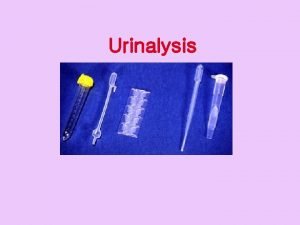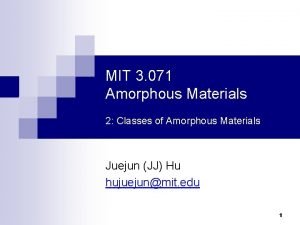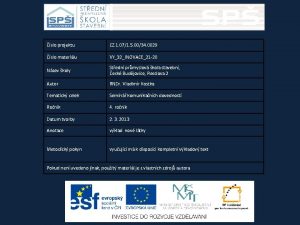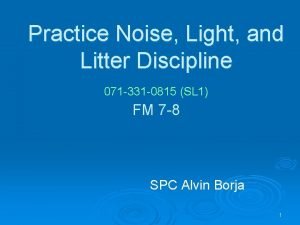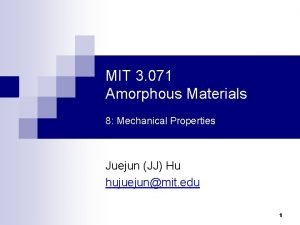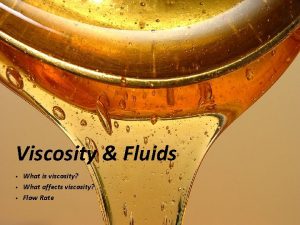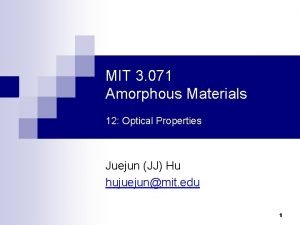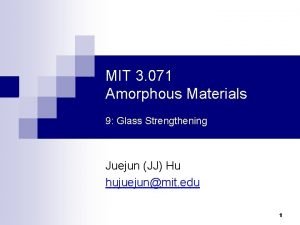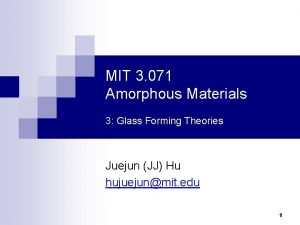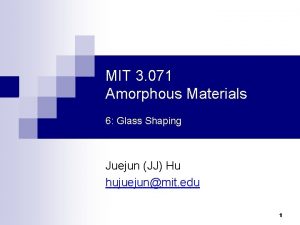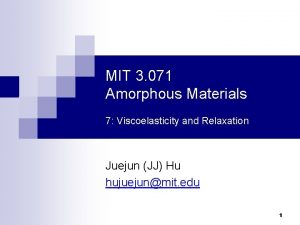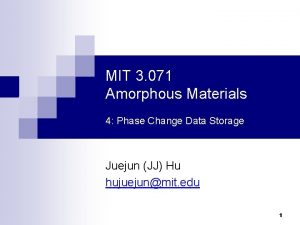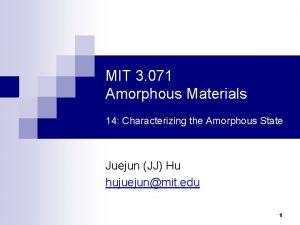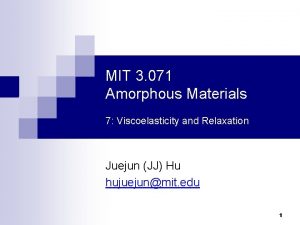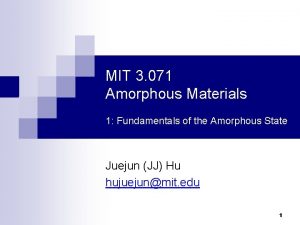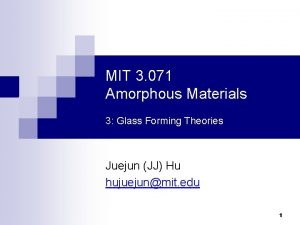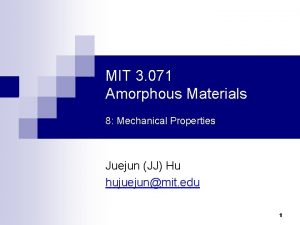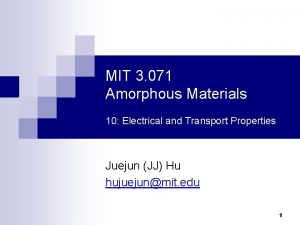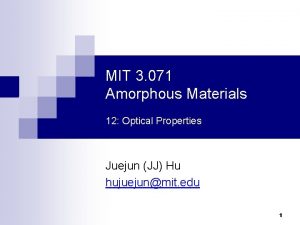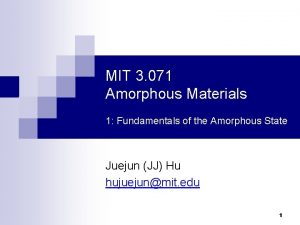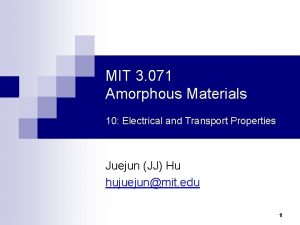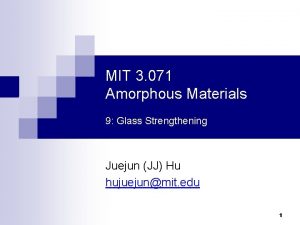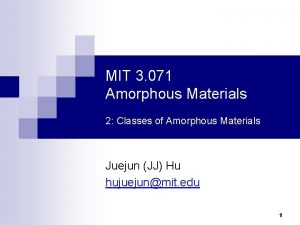MIT 3 071 Amorphous Materials 5 Viscosity of
























- Slides: 24

MIT 3. 071 Amorphous Materials 5: Viscosity of Glass Juejun (JJ) Hu hujuejun@mit. edu 1

After-class reading list n Fundamentals of Inorganic Glasses ¨ n Ch. 9 Introduction to Glass Science and Technology ¨ Ch. 6 2

The pitch drop experiment n The pitch drop experiment is a long-term experiment which measures the flow of a piece of pitch (asphalt) n The most famous version of the experiment was started in 1927 by Professor Thomas Parnell of the University of Queensland in Brisbane, Australia. The ninth drop fell on 24 April 2014, allowing the experimenters to calculate that pitch has a viscosity approximately 230 billion times that of water. Ig Nobel Prize in Physics, 2005 3

Is glass a solid or a viscous liquid? “Successful read/write of digital data in fused silica glass with a recording density equivalent to Blu-ray Disc™, enabling both greater capacity using 100 recording layers and long storage life of 300 million years. ” Hitachi Ltd. Press Release 2014 “It is well known that panes of stained glass in old European churches are thicker at the bottom because glass is a slow-moving liquid that flows downward over centuries. ” 4

Is glass a solid or a viscous liquid? V Supercooled liquid Solid Elasticity instantaneous, transient Liquid Viscosity time-dependent, permanent Glass h : viscosity E : Young’s modulus (unit: Pa·s or Poise) G : shear modulus Tm T 5

Microscopic origin of elasticity and viscosity n Elasticity: attractive and repulsive forces between atoms n Viscosity: motion of atoms/molecules relative to their neighbors (relaxation) ¨ Conformation change of (macro)molecules ¨ Vacancy diffusion ¨ Dislocation motion ü Different relaxation mechanisms have distinctive relaxation time scales ü Strong interatomic/molecular bonds give rise to high viscosity 6

Temperature dependence of elasticity Relatively weak temperature dependence M. R. Vukcevich, J. Non-cryst. Sol. , 11, 25 -63 (1972). 7

Temperature dependence of viscosity n Viscous flow is a thermally activated process In general, the activation energy DEa is temperature dependent 8

The Angell plot and fragility n Glass transition temperature Tg n Fragility parameter Fragility has nothing to do with mechanical properties of glass! 0 1 Science 267, 1924 -1935 (1995) 9

Strong vs. fragile glass forming liquids Strong liquids n Arrhenius equation n Covalent glass forming liquids n Fragile liquids n Vogel-Fulcher-Tammann (VFT) equation (Williams. Landel-Ferry equation) n Ionic and molecular liquids Fragility often exhibits a n Decrease of molecular minimum at the rigidity cluster size as temperature percolation threshold ( rises ) 10

The MYEGA equation of viscosity n The VFT equation diverges at low temperature n The Mauro-Yue-Ellison -Gupta-Allan (MYEGA) equation: Proc. Nat. Acad. Sci. U. S. A. 106, 19780 -19784 (2009) 11

Viscosity reference points Working range Glass blowing Lehr annealing Fiber drawing Float glass Pitch: 2. 3 × 108 103 101 Melting Working point 106. 6 Softening point 1012 1013. 5 h (Pa·s) Annealing Straining point (Tg) point 12

Composition dependence of viscosity High network connectivity and strong bonds lead to high viscosity 13

Mixed alkali effect (MAE) n Simultaneous presence of two alkali modifiers in glass leads to non -additive behavior (in particular transport properties) Possible mechanism: mutual blocking of transport pathways by the two ions Na 2 O K 2 O J. Non-Cryst. Solids 1, 235 (1969); J. Non-Cryst. Solids 21, 343 (1976); Phys. Rev. Lett. 90, 155507 (2003). 14

The thermometer effect “In the last century and before, most thermometers were made of ‘Thüringer Glas’ which contains silica, lime and, more importantly, equal portions of (mobile) sodium and potassium ions. The problem with these thermometers was that they were rather inaccurate. If a calibrated thermometer was put into boiling water and later into ice of 0 °C, thermometer did not show 0. 0 °C, but about − 0. 5 °C. This so -called zero point depression took several months to vanish, if thermometer was stored at room temperature. If it was heated up and cooled down, the effect occurred again. Weber found out in 1883 that this unwished relaxation effect could be diminished by a factor of 10 if only one type of alkali ion (sodium or potassium) was present in the glass, and little later Schott developed the first accurate Li-based thermometer. ” From Solid State Ion. 105, 1 -13 (1998) 15

Non-Newtonian behavior Shear stress s n Rate dependent viscosity Bingham plastic Shear thinning Newtonian fluid Shear thickening Shear rate 16

Non-Newtonian behavior Viscosity h n Rate dependent viscosity Bingham plastic Shear thinning Newtonian fluid Shear thickening Hydroclustering (Image from Wiki) Shear rate 17

Non-Newtonian behavior Viscosity h n Rate dependent viscosity Bingham plastic Shear thinning Newtonian fluid Shear rate Shear thickening Nanoscale 6, 10470 (2014). 18

Non-Newtonian behavior of soda-lime glass Shear thinning J. Non-Cryst. Solids 105, 313 -322 (1988) 19

Viscosity measurement: viscometry Parallel plate 105 109 Beam bending Rotating cylinder 106 107 101 103 Melting Working point 106. 6 Softening point 1013 1012 1013. 5 h (Pa·s) Annealing Straining point (Tg) point 20

Precision viscometry based on optical interferometry Corning Inc. “… the data reported are related to a single fused silica plate whose absolute shape was monitored over a period of 6 years during which the plate maintained the same posture; … The deformations that have to be detected are at the scale of the nanometre, over a lateral size of 100 -150 mm…” M. Vannoni et al. , Eur. Phys. J. E 34, 92 (2011). 21

Is glass a solid or a viscous liquid? “Chocolate Melts, Flowers Wilt, Diamonds are Forever” Glasses “Depending on thermal history of the glass, the room temperature viscosity is on the order of 1024 to 1025 Pa·s. . . Using analytical expressions to describe the glass flow over a wall, we calculate a maximum flow of ~1 nm over a billion years. ” DOI: 10. 1111/jace. 15092 22

Summary n n Constitutive relations for linear elasticity and Newtonian viscosity ¨ Elastic deformation: instantaneous, transient ¨ Viscous flow: time-dependent, permanent Temperature dependence of elasticity and viscosity ¨ Elasticity: results from interatomic forces with minimal temperature dependence ¨ Viscosity: motion of atoms/molecules with respect to neighbors, thermally activated process 23

Summary (cont’d) n n Fragility of glass forming liquids: temperature dependence of activation energy in viscous flow ¨ Strong liquid: Arrhenius equation ¨ Fragile liquid: VFT equation, size of collective motion units (molecular clusters) increases as temperature decreases Composition dependence of viscosity ¨ Mixed alkali effect n Non-Newtonian viscous flow n Viscometry techniques 24
 Amorphous disk mark
Amorphous disk mark Metal deficiency defect
Metal deficiency defect Is cotton candy anisotropic
Is cotton candy anisotropic Clinitest®
Clinitest® Polycrystalline solids
Polycrystalline solids During the summit the factious ambassador caused
During the summit the factious ambassador caused Spermatozoma
Spermatozoma Mit
Mit Crystal solid and amorphous solid
Crystal solid and amorphous solid Amorphous pronunciation
Amorphous pronunciation Chem
Chem Amorphous in urine
Amorphous in urine Crystalline solid and amorphous solid
Crystalline solid and amorphous solid 071 atm code
071 atm code 071-com-4407
071-com-4407 071-com-0510
071-com-0510 Perform surveillance without the aid of electronic device
Perform surveillance without the aid of electronic device 071-com-0029
071-com-0029 Hello
Hello Practice noise light and litter discipline powerpoint
Practice noise light and litter discipline powerpoint Pb 071
Pb 071 071-com-4407
071-com-4407 Land navigation terrain features
Land navigation terrain features N 3^071
N 3^071 Bcd addition of 184 and 576
Bcd addition of 184 and 576



